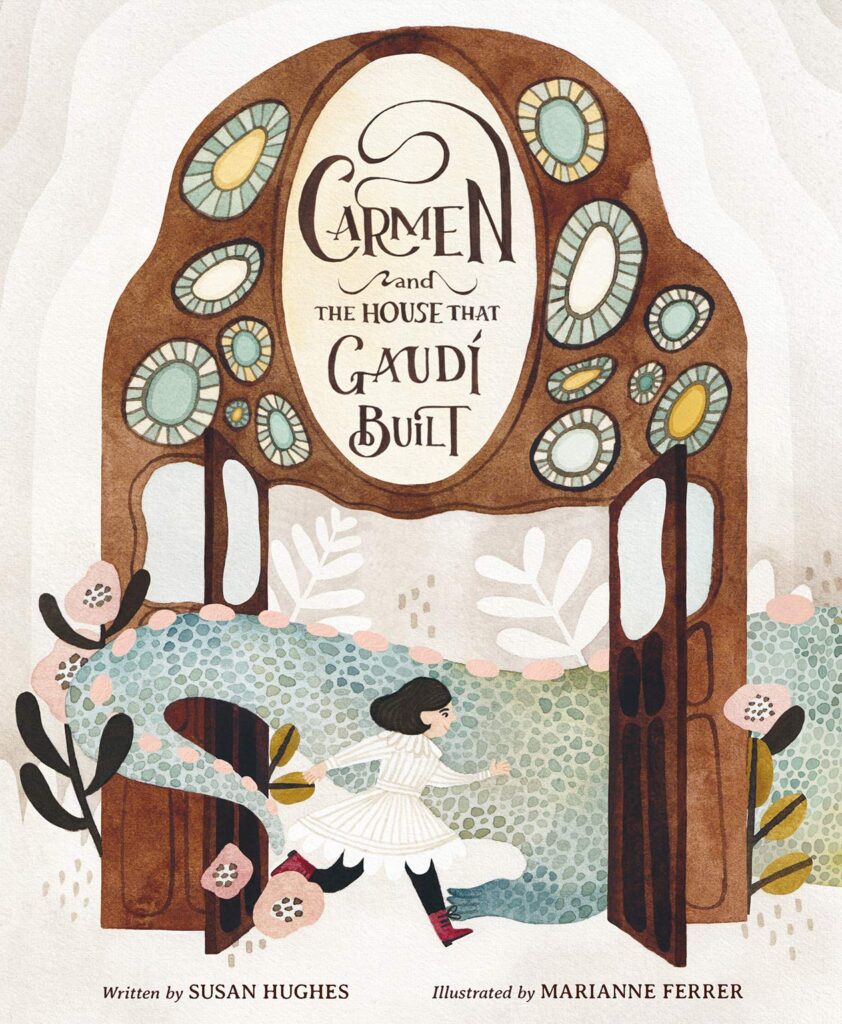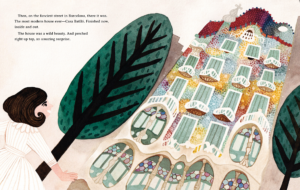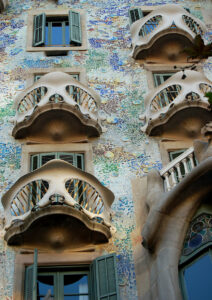
Owlkids Books | 978-1771473927
Carmen’s Mama and Papa have bought a new house on a fancy street in Barcelona and the family will be moving from their home in the country to the city. Carmen is none too happy because she will have to leave Dragon, her imaginary salamander.
“But what would she do without her friend and the wild beauty of the woods they roamed together everyday?…
Could Carmen ever feel at home in the gray, stiff, steel city?”
Though the interactions between the architect Antoni Gaudí and Carmen and her family are creations of author Susan Hughes’ imagination, readers will enjoy this engaging introduction to Casa Batlló, the unique home Gaudí redesigned and renovated between 1904 and 1906.
Using color, mosaics, and the creative diffusion of light, Gaudís Casa Batlló, sometimes known as the “House of the Dragon” because of its colorful roof resembling the spiny back of a dragon – or perhaps Carmen’s salamander? – is a UNESCO World Heritage site. Stunning watercolor illustrations by Marianne Ferrer bring the magic of Hughes’ story and Casa Batlló to young readers.
After reading CARMEN and the HOUSE THAT GAUDI BUILT, I was anxious to learn more and asked Susan Hughes a few questions!

CLICK TO ENLARGE © illustration by
DIANNE: Hi, Susan! Thanks for introducing young readers to Casa Batlló.
In your bio for the book, readers learn that a trip to visit Casa Batlló inspired you to write about this unusual UNESCO World Heritage site. In the backmatter, you indicate that although the interactions “between Gaudí and Carmen and her family are imaginary, the descriptions of the architect’s ideas about design and beauty—although they seem fantastical— are based on facts.”
Can you talk about the considerations that led you to decide to use this very engaging fictional approach?
SUSAN: Well, after my trip, I was certain I would write a picture book biography about Antoni Gaudí himself, but after researching about the architect and learning more about his ideas, I changed my mind. I decided the most compelling way to help kids really connect with his work and feel the excitement of his architecture was to do more than tell them about Gaudí’s life and his ideas. Instead, I decided I’d offer them a similar experience to mine: allowing them to enter into one of his structures and see his ideas in action for themselves. And I believed it might be more meaningful for kids if the story focused on a child rather than on Gaudí, if a child character engaged with both Gaudí and one of his buildings, if they saw how it came to be.
When I researched Casa Batlló and learned that one of the Batlló children, Carmen, would have been around 11 years of age at the time Gaudí was hired to renovate the house, I knew I had to write about this particular house, that my main character would be fictional but Carmen would be my “touchstone” for her, and that she would meet Antoni Gaudí. I would show their interaction having an impact on the design on the house—a completely fictional element but rooted in possibility!

CLICK TO ENLARGE photo © Alscardoso
DIANNE: Gaudí made many artistic and structural changes to the original house. What were some of the most interesting facts that you uncovered during your research? Was there a room or element of the house and/or house’s design that you found particularly fascinating?
SUSAN: I loved discovering that Antoni Gaudí used a special mosaic design technique called “trencar” in his work. “Trencar” means “to break” in Catalan. Gaudí used broken ceramic tiles to create mosaic forms and shapes on the façade of Casa Batlló and in its “light well”, and on many other of his amazing structures in Barcelona.
Also, like Gaudí, I love rooms with lots of natural light. In fact, when I write, I sit in front of big windows in my home, either in my living room or in my office space. So, I love the way Gaudí prioritized bringing light into Casa Batlló.
It was challenging because the building is essentially a low-rise apartment building or townhouse with 8 floors, bordered by other buildings, which means there is no possibility for windows on either side.
Of course, I love the large gorgeous front windows in Casa Batlló with their colorful stained glass borders. But I also admire how Gaudí found a creative way to add more light to the interior of the house. He created a “light well,” which is essentially a long shaft running from ceiling to basement, open to each floor level. Light pours in through the huge skylight on top and fills the house with light on each level. And Gaudí installed a lift in the shaft, and the wooden lift car is still functioning. I rode in it myself!
DIANNE: You’ve written more than 30 books – everything from board books to picture books, chapter books to middle grade, nonfiction, fiction, and even several chapter books series. What are you working on now? What can readers look forward to next?
SUSAN: As always, I have several manuscripts out on submission and I’m working on several others right now, all in different stages of drafting. I’m excited that I have one more picture book in my Science of How series with Kids Can Press coming out this fall—Light and Night: The Science of How Light Works, illustrated by Ellen Rooney—and two picture books coming out with Owl Kids Books next year!
DIANNE: Thanks, Susan, for visiting ReaderKidZ and for sharing some of book’s background and the writing of CARMEN and the HOUSE THAT GAUDI BUILT!
- Readers can learn more HERE about Susan Hughes and her two newest books: SOUNDS ALL AROUND, illustrated by Ellen Rooney and WALKING FOR WATER: How One Boy Stood Up for Gender Equality, illustrated by Nicole Miles.
- For those interested in learning more about Casa Batlló, enjoy this video tour of the home.










